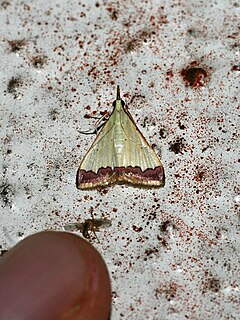
Alfred Jefferis Turner was a pediatrician and noted amateur entomologist. He was the son of missionary Frederick Storrs-Turner. He introduced the use of diphtheria antitoxin to Australia in 1895. He was known by the nickname "Gentle Annie".
Dolichobela is a monotypic moth genus of the family Crambidae described by Alfred Jefferis Turner in 1932. It contains only one species, Dolichobela celidograpta, described in the same publication, which is found in Australia, where it has been recorded from Queensland.

Autocharis hedyphaes is a moth of the family Crambidae described by Alfred Jefferis Turner in 1913. It is found in south-eastern Asia, including Malaysia. It is also present in Australia in northern Queensland.
Cryptadia is a monotypic snout moth genus described by Alfred Jefferis Turner in 1913. Its single species, described in the same publication, Cryptadia xuthobela, is known from Australia.
Dialepta is a monotypic snout moth genus described by Alfred Jefferis Turner in 1913. Its only species, Dialepta micropolia, described by the same author, is found in Australia.
Axiocrita is a monotypic snout moth genus. It was described by Alfred Jefferis Turner in 1913 and contains the species Axiocrita cataphanes. It is found in Australia.
Glyphipterix pyrophora is a species of sedge moth in the genus Glyphipterix. It was described by Alfred Jefferis Turner in 1913. It is found in Australia, including New South Wales.
Eurhythma argyphea is a moth in the family Crambidae. It was described by Turner in 1913. It is found in Australia, in the Northern Territory.
Agrotera glycyphanes is a moth in the family Crambidae. It was described by Alfred Jefferis Turner in 1913. It is found in Australia, where it has been recorded Queensland.

Metasia spilocrossa is a moth in the family Crambidae. It was described by Alfred Jefferis Turner in 1913. It is found in Australia, where it has been recorded from Queensland.
Catephia compsotrephes is a species of moth of the family Erebidae first described by Alfred Jefferis Turner in 1932. It is found in north-western Australia.
Syllepte trachelota is a moth in the family Crambidae described by Alfred Jefferis Turner in 1913. It is found in Australia, where it has been recorded from Queensland.
Eutorna rubida is a moth in the family Depressariidae. It was described by Alfred Jefferis Turner in 1919. It is found in Australia, where it has been recorded from Victoria.
Pedois epinephela is a moth in the family Depressariidae. It was described by Alfred Jefferis Turner in 1947. It is found in Australia, where it has been recorded from Queensland.
Imma loxoscia is a moth in the family Immidae. It was described by Alfred Jefferis Turner in 1913. It is found in Australia, where it has been recorded from the Northern Territory and Queensland.
Imma platyxantha is a moth in the family Immidae. It was described by Alfred Jefferis Turner in 1913. It is found in Australia, where it has been recorded from Queensland.
Heosphora erasmia is a moth in the family Pyralidae. The species was first described by Alfred Jefferis Turner in 1913. It is found in Australia.
Heosphora leuconeura is a moth in the family Pyralidae. The species was first described by Alfred Jefferis Turner in 1913, as Poujadia leuconeura from a specimen collected in Darwin in the month of March. The species epithet, leuconeura, describes the moth as being "white-nerved". It is found in Australia.
Heosphora baliora is a moth in the family Pyralidae. The species was first described by Alfred Jefferis Turner in 1913. It is found in Australia.
Heosphora neurica is a moth in the family Pyralidae. The species was first described by Alfred Jefferis Turner in 1913. It is found in Australia.


